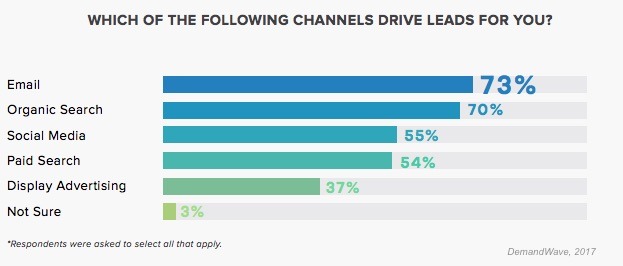A brief definition first:
A lead is a qualified contact [character and appearance match] with a prospective customer [or prospect] who is interested in a product [i.e., you] and provides the advertiser [you] with his or her address information [cell phone number] for further dialogue development and is highly likely to become a customer [potential partner].
Congratulations! Generating leads is apparently in your wheelhouse. Since you are reading this article, I assume that you are still busy generating leads – perhaps in the meantime no longer in a private, but in a professional context.
Because qualified contacts are also important for companies to sell their products or services and to increase the company’s success.
Since you started generating leads at an early stage – without knowing it – you already have the best prerequisites. Our goal today is to expand your skills and understanding of new customer acquisition a bit more and to give you a few useful tips.
What does lead generation mean and what do I need leads for?
A lead is a potential prospect for your product or service. The more data you have on this person, the better.
In our example above, you probably only knew the potential prospect’s first name, cell phone number, and possibly age. If you did your job well, you could also find out some of your new contact’s interests.
In a professional context, information such as the email address, the extension number of the work phone, the position, the industry and the needs of the prospect are also interesting.
The goal is to collect as much of this data as possible and create your own database of prospects. By targeting prospects, companies hope to further expand their customer base and increase sales and revenue.
Classic online marketing channels for acquiring new customers and why they work
Now we know what a lead is and why they are so interesting for companies. But how do you actually get leads? Which communication channels are most effective for reaching customers efficiently?
The web marketing agency DemandWave examined this question in a study. The results are the following five channels:

The industry experts surveyed found email marketing to be the most effective method for generating leads, with 73%. This result is hardly surprising, because email marketing is a real all-rounder when used correctly. For example, a regular newsletter can be used to address not only existing customers but also new customers.
At 70%, organic search results achieved second place in the ranking. SEO measures are one of the most important instruments for attracting as many visitors as possible to one’s own website. But paid search results are also represented in the ranking with 54%, and thus 4th place.
Another effective method of acquiring new customers is social media marketing. It landed in third place in the study.
Social media marketing has a major advantage here: prospective customers can follow the company with just one click – without much effort, without having to fill out forms or the like.
Via interesting content, the next step to product purchase is not far away. Incidentally, LinkedIn (62%) was chosen as the most popular channel for lead generation, followed by Twitter (34%).
Display advertising made it to 5th place with 37%. This includes banner ads, videos and pop-ups. Although display advertising does not have a particularly good reputation, and customers repeatedly complain that they feel annoyed by the windows popping up on the screen – which block the entire screen and have to be clicked away all the time – and the growing use of ad blockers has declared war on them, in practice they still seem to have a raison d’être.
The study thus maps five channels of new customer acquisition that have already been used successfully in many companies for many years. Personal contact at trade fairs or events or holding a sweepstake are also still popular methods of lead generation.
While these methods are tried and tested, surprising your potential customers with these methods will probably be rather difficult. Between all the red buttons, glaring headlines, and annoying pop-ups, there’s one thing that’s often forgotten: the value proposition. Or as our headline says:
The deal with your prospects
Let’s assume the following scenario: Gardener Gary is researching the World Wide Web for ecologically safe pesticides. As a gardener, nature is naturally close to his heart and he would like to switch to an environmentally friendly option for fertilizing his plants. He comes across the site of a company that advertises with a lot of expertise to produce “green” sustainable fertilizers for plants – exactly what Gary is looking for.

Gary signs up for the company’s newsletter. He gladly provides his data, expecting to receive added value through the newsletter. For Gary, this added value could, for example, be in the form of key figures, comparative tests with toxic substances or interesting input on the areas of plants or gardening.
A week later he receives the first newsletter. It is full of spelling mistakes, without a real concept and only offers gardener Gary the purchase of lawn mowers.
Gary doesn’t need a lawn mower, he’s interested in plant protection products. What will happen? Well, Gary is probably abruptly no longer interested in the products, will immediately unsubscribe from the newsletter and start looking for another company.
This is a classic case of not delivering on the value proposition.
Therefore, before actually generating leads, ask yourself what you can offer your prospects in return for receiving them.
Here, the magic word is content marketing.
Through so-called magnetic content, all SEO-optimized of course, you succeed in luring your target group to your website.
On the landing page, you now have the opportunity to state your value proposition briefly and concisely: Headline, short text, advantage, what makes the offer special? The prospective customer knows immediately what he will receive.
The service in return can be, for example, participation in a free webinar or the download of a guidebook, a white paper or a checklist.
Other “bait” can also be discount codes, free tickets, coupons or product samples. Pay attention here to the quality of your consideration, because otherwise it goes to your prospects like Gary the gardener.
By downloading the content, registering for the webinar or redeeming the discount code, the visitor shows his loyalty and thus becomes an active lead who is guided step by step to the product.
A positive side effect of this type of new customer acquisition: the prospect takes the first step out of his own motivation. One disadvantage, however, is that content marketing is expensive and complex and accordingly requires a lot of time to build up.
The familiar online marketing channels are exhausted – what now?
But what to do when the familiar channels are exhausted? Don’t worry: there are still many other ways to generate leads. Today, we’re going to look at three interesting methods:
Social Media Marketing
No question about it, social media like Facebook, Instagram, Twitter and Co. are popular. Due to their high user numbers and the daily activity of their users, social networks are a good way to generate prospects, increase customer loyalty and present your own company in a customer-oriented way.
Influencer marketing is an increasingly popular option. Here, an influencer receives free products or remuneration from a company and, in return, presents the products on their own social media channel.
Due to the existing relationship of trust between the influencer and his community, this type of advertising is often equated with a recommendation from a friend and is therefore very effective.
The platforms also offer companies targeted opportunities to place advertisements and thus reach potential customers. In addition to age, gender and place of residence, it is even possible to filter by interests. This means that the target group can be narrowed down fairly precisely. The costs depend, among other things, on the duration and quality of the ad, the click or conversion rate, but can be adjusted to your own budget.
Our tip: First test a small advertising budget in various social networks and find out how the advertising is received by users. Based on that you can choose the platform with the best results.

Interactive methods
However, new customer acquisition can also be done in an interactive and playful way. These include quizzes, calculators or tests on topics such as psyche, love or jobs, guides, surveys or advent calendars.
New customer acquisition that is fun for your users increases your success rate in generating new customers. This is because you are creating interaction with the prospect right from the start and giving them added value even before they contact you.
For more creative ideas, check out our blog article on creative and interactive lead generation.
Address buying
Another option is address buying. Providers for the purchase of address data can be found in the vastness of the Internet without end. The advertising promises are enormous:
“Leads within 5 minutes”, “Get to your goal faster with high-quality leads”, “Lengthy lead generation was yesterday” …
But do these providers keep their promises? Does buying addresses really make sense? And what should you look out for?
At first glance, the headlines are convincing. I buy contacts that are exactly tailored to my industry and save a lot of working time. With a few clicks, I get a seemingly endless list that I only have to work through.
That’s the idea at first. But in reality, the transmitted quality is not always convincing. The data has not been qualified in advance, is incorrect or outdated. The contact person named on the list, for example, left the company years ago, and I’m already back to checking data that I actually wanted to save myself. Some providers at least offer a risk check of the companies. This also makes sense, because otherwise you quickly get a list of insolvent companies that are unlikely to become customers of yours.
The topic of address buying should therefore be approached with caution. An address purchase can make sense if the provider is sufficiently reputable and the data has been qualified accordingly. A particularly fast, particularly cheap or totally great, should rather discourage here. We therefore recommend that you check the provider and the quality of the list carefully.
It is also important to check in advance the legal requirements of the respective country, which data may be used at all. There are a number of differences between countries that need to be taken into account here. In Germany, for example, the recipient must have consented to receiving advertising emails.
Therefore: Not all leads are the same – quality trumps quantity.
Your goal should not be to generate as many leads as possible, but rather high-quality leads.
A qualitative lead differs from an unqualified lead in particular by the presence of current contact data and the amount of information available, such as the needs or wishes of the prospect.
The more such data is available, the more targeted marketing strategies can be used and the chance that the lead will become a customer increases.
If a prospect has already dealt with the offered product or service or has already contacted you on his own initiative, this is also to be understood as a qualification of the lead.
On the other hand, an unqualified lead usually requires more work, for example, to process missing or incorrect contact data. Or higher marketing costs, which are also less promising than with a qualified lead.
The lead funnel

1st level – Lead
John Doe is interested in a new car. So he googles the search term “new car 2021” and lands on the page of a car dealership near him. Apparently, the car dealership has done a good job in terms of SEO.
To make sure John doesn’t miss any more new releases, he signs up for the company’s newsletter. That’s it: John is a lead.
2nd level – Marketing Qualified Lead
To get to the second level, i.e. to become a qualified contact, the car dealership needs further contact data from John.
For example, the company should have the prospect’s full name and at least two pieces of contact information, such as phone number and email address. For business customers, data such as contact person or company name may also be of interest.
But how does the car dealership get this data now?
As already learned, this will be difficult without a concrete service in return, so the car dealership has thought of something: It offers all prospective customers a free configurator, with which the potential new customers can put together their dream car themselves. All the company asks in return is that the customer provide the specified data.
John is thrilled; this way he can configure his dream car even before it appears. He gets started right away…
3rd level – Sales Accepted Lead
John has configured his dream car. In order to receive the result with an exact list of all optional extras, he had to enter his contact details. He received the result immediately by email in his inbox.
John is thrilled. In the meantime, John‘s stored data is transferred from the marketing to the sales department. Here, another check is carried out. Will John Doe be a potential new customer? Does it make sense to approach him? Is the available information sufficient for a successful conversation? This can also be done completely automatically via a CRM system.
4th level – Sales Qualified Lead
John Doe has successfully passed all the screening steps and is now available as a hot lead. This means that specific content is made available to him by the sales department. The content relates to meeting his needs and is intended to persuade John to make a purchase.
What happens after that? Keeping leads warm
Yeah, that worked. John has ordered a new car. He’s really excited and can’t wait to get in and drive it.
And what happens to John‘s contact data? The car has been ordered, so the company is not interested in negotiating with John again. He is unlikely to buy another car.
Communication is the magic word.
John is still subscribed to the newsletter and thus receives regular emails about all the latest market developments. In addition, he continues to be looked after as a customer by the dealership.
For example, shortly after receiving his new car, he receives an email telling him whether he is satisfied with his new car and is sent a small gift in the form of a key fob as a thank you.
Service offers such as tire or oil changes or inspections are also made to him at regular intervals. This way, customer and company stay in touch and the lead is kept warm. John’s wife Jane may also soon need a new car, and John certainly has the dealership in mind.
The biggest mistakes in lead generation
Finally, we would like to discuss possible problems or mistakes when generating leads. These include:
Too frequent promotional emails
Yes, the product is great and you would like to tell the whole world about it. But too frequent mailings usually have the opposite effect and prospects feel harassed. This can quickly lead to readers unsubscribing from newsletters or other email campaigns.
Therefore, it is important to handle advertising mails in a well-dosed manner.

Disregard the legal background
When sending promotional emails, there are a number of things to consider in terms of data protection law. For example, the recipient’s data may only be stored, processed and used if the recipient has consented.
In addition, all emails must include an opt-out option to unsubscribe from the distribution list. Failure to comply can result in anything from a warning to considerable penalties and should therefore be avoided at all costs.
Missing lead definition
Jared has a dog. Bobby is a little mongrel who makes a real mess of his life. So Jared is the right target group for dog food and accessories. For cat food manufacturers, however, he is completely uninteresting.
Sounds logical, doesn’t it? But companies are always struggling to reach people who are not accessible to them at all. Firstly, there is often a lack of sufficient quality in the available data and secondly, a lack of target group definition.
As a result, dog fan Jared is repeatedly bombarded with ads for cat products that he can’t relate to. On the contrary: he doesn’t even like cats. Since Jared has already been fed content for weeks, marketing wrongly assumes that he is a warm lead. The sales department takes over, writes mails and calls him repeatedly.
Result: Jared is annoyed, the sales representative is frustrated and angry with his marketing colleagues, and the CEO is annoyed about the high advertising costs without revenue.
With a clear lead definition, this mistake can be avoided and it will save you costs, frustration and time.
Poorly maintained data
Poorly maintained data sets cost time, nerves and money. In many companies, the painstakingly collected data is entered into the system only once and then left to its own devices. However, email addresses and telephone numbers change, contact persons leave the company and typing errors creep in during manual entry. The lead thus becomes unusable.
Regular maintenance of existing data records is therefore important, because subsequent correction is often difficult and employees waste important working time.
This can be remedied by designating responsibilities for maintenance and clear collection methods. Furthermore, it makes sense to document marketing efforts and completed sales processes to get a better overview.
Conclusion
If you avoid these four mistakes, you’re well on your way to lead generation. And otherwise:
Remember your early days. Without charm, you probably wouldn’t have gotten the number of your former hottie. It’s the same with lead generation. Smart and creative will get you further than a clumsy pickup line.
With this article, we would like to give you a few new ideas for your lead generation. But keep in mind: Every company is individual, the new customer acquisition that works great for one company can flop for the next. Therefore, check for yourself which channels work best for your product and company. And if you don’t generate masses of leads at first, remember that it’s not about the mass, but the class of the leads.
We wish you continued success in generating new prospects that become customers.
More on the topic of lead generation:
- Blog
- Templates for Lead Generation
- More



